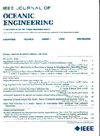基于残差空间协同注意模块的自监督学习水下目标检测
IF 5.3
2区 工程技术
Q1 ENGINEERING, CIVIL
引用次数: 0
摘要
水下目标探测技术的性能受到各种因素的制约。首先,在水下图像数据集中,存在色差、低对比度、模糊等退化现象,影响检测算法的准确性。其次,水下图像数据集难以获取,制作标记数据集的成本较高,这也阻碍了水下目标检测算法充分发挥其潜力。本文提出了一种用于水下目标检测的自监督学习网络。针对传统对比学习网络注重全局信息而忽略局部信息的不足,在基线SimSiam网络中加入一个受掩模自编码器启发的辅助分支,辅助分支协同主分支对目标网络进行优化,帮助目标网络学习目标特征图的局部信息。在自监督学习网络中嵌入残差空间协同注意模块,通过残差结构获取远程信息,构建空间语境特征。采用合作注意的方法增强特征学习能力。在重建的水下目标数据集上进行了实验。结果表明,与基线网络相比,本文提出的方法更适合水下环境,具有更好的平均精度。本文章由计算机程序翻译,如有差异,请以英文原文为准。
Underwater Target Detection by Residual Spatial Cooperative Attention Module–Based Self-Supervised Learning
The performance of underwater target detection techniques is limited by various factors. First, in underwater image data sets, there exists degradation such as color bias, low contrast, and blurring, which affect the accuracy of the detection algorithms. Second, the underwater image data set is difficult to obtain and the cost of making the labeled data sets is high, which also prevents underwater object detection algorithms from fully leveraging their potential. In this article, we propose a self-supervised learning network for underwater target detection. Considering the deficiency that the conventional contrastive learning network pays more attention to the global information and ignores the local information, an auxiliary branch inspired by masked autoencoders is added to the baseline SimSiam network, which collaborates with the main branch to optimize the target network and help the target network learn the local information of the target feature map. A residual spatial cooperative attention module is proposed to be embedded within the proposed self-supervised learning network to obtain remote information through residual structure and construct spatial context features. The method of cooperative attention is used to enhance feature learning ability. Experiments are carried out on a reconstructed underwater target data set. Results show that compared with the baseline network, the method proposed in this article is more suitable for underwater environments and has better mean average precision.
求助全文
通过发布文献求助,成功后即可免费获取论文全文。
去求助
来源期刊

IEEE Journal of Oceanic Engineering
工程技术-工程:大洋
CiteScore
9.60
自引率
12.20%
发文量
86
审稿时长
12 months
期刊介绍:
The IEEE Journal of Oceanic Engineering (ISSN 0364-9059) is the online-only quarterly publication of the IEEE Oceanic Engineering Society (IEEE OES). The scope of the Journal is the field of interest of the IEEE OES, which encompasses all aspects of science, engineering, and technology that address research, development, and operations pertaining to all bodies of water. This includes the creation of new capabilities and technologies from concept design through prototypes, testing, and operational systems to sense, explore, understand, develop, use, and responsibly manage natural resources.
 求助内容:
求助内容: 应助结果提醒方式:
应助结果提醒方式:


